A train station isn’t exactly the kind of place you would be expected to slow down and do some serious art appreciation. But if you miss the two awesome sculptures in Philadelphia’s 30th Street Station, you’ll be worse off than if you had missed your train. These sculptures will – pardon the railroad pun – stop you in your tracks.
But first, let’s consider the station itself, which is a nexus between our two centers of power on the east coast: Washington DC and New York City. It is one of America’s busiest transit points, handling roughly 4 million travelers a year.
A Venerable Station
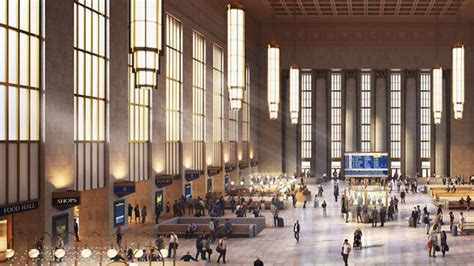
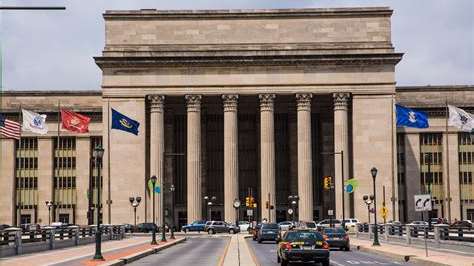


Philly’s 30th Street Station is not your standard lifeless, boring public space. It’s quite classy and could be a first cousin to New York City’s Grand Central Station. Philadelphians built it in the midst of the Great Depression (1933) when American architects still hadn’t succumbed to the worst habits of ugly functionalism in public buildings.
It is built in the neo-classical style (giant Corinthian columns, coffered ceilings, lots of marble) but also incorporates modern features like decorative sconces and lighting (oh, and a food court with a Dunkin Donuts too…of course.)
One of the best parts of the station is that it still retains one of those old Solari schedule boards that makes clicking sounds like a skeleton clattering across the marble floor as the board flips through its constantly changing numbers and travel destinations. It entertains as it informs. Most other train stations today have upgraded to electronic schedule boards – alas – but there is nothing quite like the old noisy Solari board to add pizazz to your travel experience.
The venerable depot is such an emblematic train station that it has been featured in no fewer than ten movies since 1945.
The Angel of the Resurrection
Then there’s the angel.
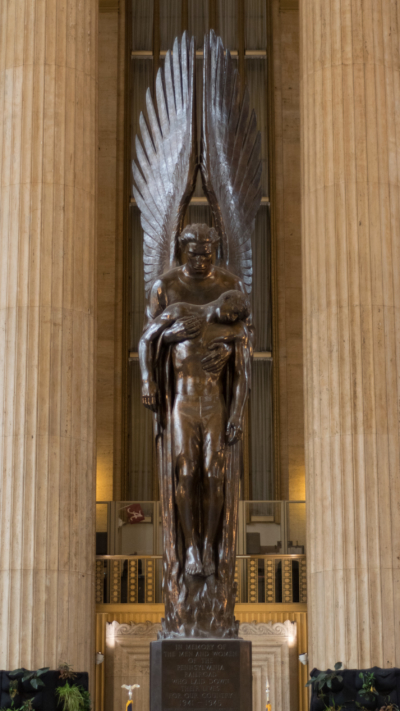 At one end of the massive open terminal looms a 39-foot statue that is so perfectly suited to its environment that you could mistake it for part of the original structure. The impressive “Angel of the Resurrection” hovers over all who pass through the space on their way to wider destinations:
At one end of the massive open terminal looms a 39-foot statue that is so perfectly suited to its environment that you could mistake it for part of the original structure. The impressive “Angel of the Resurrection” hovers over all who pass through the space on their way to wider destinations:
- It is extremely tall to proportionally fill the immense space (the ceiling rises some 80+ feet overhead); certainly a smaller sculpture would be dwarfed by the dimensions of the terminal;
- It is crafted on a vertical axis, neatly framed by the surrounding Corinthian pillars which are its backdrop; the vertical presentation raises the viewers’ hearts (and in this case eyes) upward, which is what all good art does;
- It is made entirely of bronze, which contrasts nicely with the lighter shades of the marble pillars behind it, yet it doesn’t stand out as a sore thumb;
- And the best part: it’s all about people.
The American sculptor, Walter Hancock, crafted the 9.5-ton piece of bronze in 1953 to commemorate the 1,307 Pennsylvania railroad workers who gave their lives in service to our country during the Second World War.
From an artistic point of view it is a colossal statue; from a cultural and spiritual point of view it is a monument to those who made the supreme sacrifice for us.
And that’s the point of monuments. Societies need tangible ways to remind themselves of the men and women whose sacrifices form the bedrock of their current civic life. A friend of mine noted that it wasn’t all that long ago that religious imagery was still part of our culture and was even permitted in the public square. How different things are today.
That’s also why it is such a scandal today that ideologically-motivated groups are tearing down commemorative statues of our nation’s history and heroes. We find our heritage and collective identity in these monuments. What is more shocking to me is the passivity of our culture that allows them to do it.
The Angel of the Resurrection
Then there’s the angel.
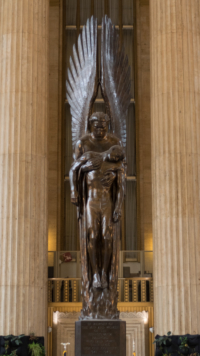 At one end of the massive open terminal looms a 39-foot statue that is so perfectly suited to its environment that you could mistake it for part of the original structure. The impressive “Angel of the Resurrection” hovers over all who pass through the space on their way to wider destinations:
At one end of the massive open terminal looms a 39-foot statue that is so perfectly suited to its environment that you could mistake it for part of the original structure. The impressive “Angel of the Resurrection” hovers over all who pass through the space on their way to wider destinations:
- It is extremely tall to proportionally fill the immense space (the ceiling rises some 80+ feet overhead); certainly a smaller sculpture would be dwarfed by the dimensions of the terminal;
- It is crafted on a vertical axis, neatly framed by the surrounding Corinthian pillars which are its backdrop; the vertical presentation raises the viewers’ hearts (and in this case eyes) upward, which is what all good art does;
- It is made entirely of bronze, which contrasts nicely with the lighter shades of the marble pillars behind it, yet it doesn’t stand out as a sore thumb;
- And the best part: it’s all about people.
The American sculptor, Walter Hancock, crafted the 9.5-ton piece of bronze in 1953 to commemorate the 1,307 Pennsylvania railroad workers who gave their lives in service to our country during the Second World War.
From an artistic point of view it is a colossal statue; from a cultural and spiritual point of view it is a monument to those who made the supreme sacrifice for us.
And that’s the point of monuments. Societies need tangible ways to remind themselves of the men and women whose sacrifices form the bedrock of their current civic life. A friend of mine noted that it wasn’t all that long ago that religious imagery was still part of our culture and was even permitted in the public square. How different things are today.
That’s also why it is such a scandal today that ideologically-motivated groups are tearing down commemorative statues of our nation’s history and heroes. We find our heritage and collective identity in these monuments. What is more shocking to me is the passivity of our culture that allows them to do it.
Another Impressive Work
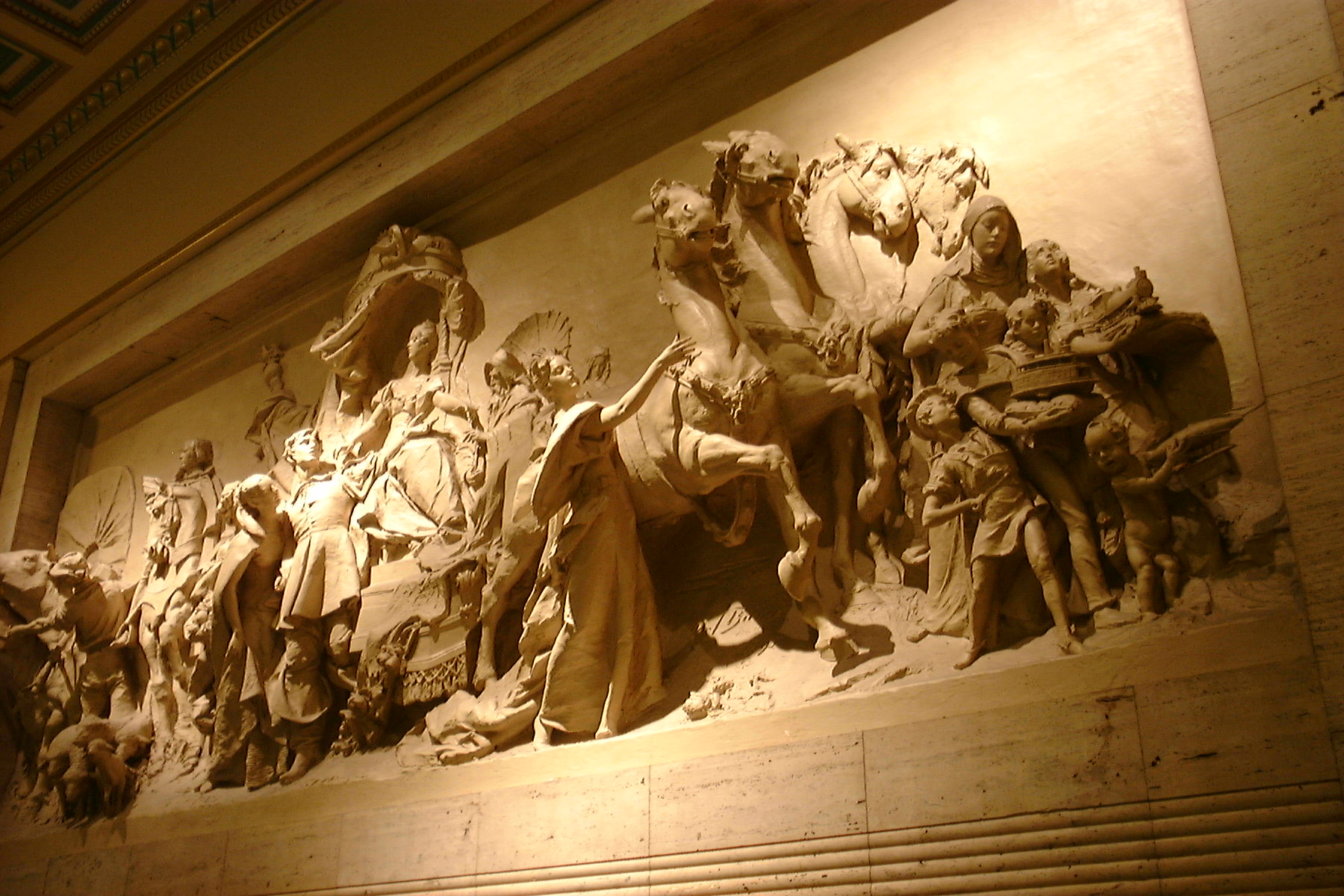
The real gem of a sculpture you could miss as you pass through the station, however, is a bas relief called “The Spirit of Transportation” located in the passenger waiting area off the main terminal.
(A bas relief is not a free-standing statue but a sculpted work attached to a wall. In this case and many others, it gives the appearance of a scene emerging from the very wall itself.)
This incredible work was carved in 1895 by the prolific Austrian-American sculptor, Karl Bitter, during our country’s Industrial Revolution. It celebrates, in kind of a triumphal procession, the progress of transportation from beasts of burden to machines of power and speed with some benign goddess in the middle standing watch over the whole realm of progress.
I would draw your attention to the family on the far right side of the pageant. Two of the older children hold images of the modes of transportation that were dominant in the late 1800s: a steam engine and a steam boat.
But the little child at the bottom holds what was then a technology in its infancy: manned flight (represented by some sort of dirigible). It is appropriately held by the youngest child, barely more than an infant himself.
A Reminder of Our Blessings
Just imagine: Bitter carved this work 125 years ago – at the very dawn of the automobile and well before the invention of the airplane! He and his generation could hardly have fathomed the technologies that have since taken us to the moon and back.
Here is another lesson about the monuments of bygone eras. They can be forward-looking and even prophetic, as this one is, but their real value lies in the backward glance they offer to future generations. They humble us as they remind us of what we owe to past workers, leaders, and geniuses for the blessings we now take for granted.
It reminds me of a quote from Ronald Reagan who was once asked if he was aware of all the things a computer could do, and he responded, “Yes, I am. My generation built it.”
If you’re interested in some homespun videos of the 30th Street Station and its monuments (somewhat poor in quality but still interesting), check out these two links.
Angel of the Resurrection (duration, 1:12) | Spirit of Transportation (duration, 2:44)
———-
[This article is a reproduction of the Sacred Windows Email Newsletter of 11/28/21, so it does not end with the regular Soul Work section. Please visit our Newsletter Archives.]

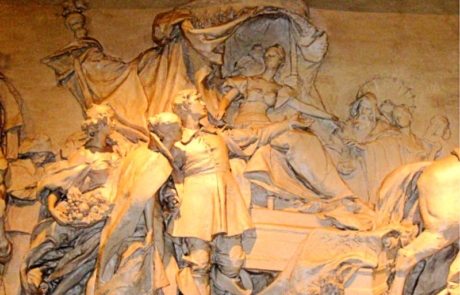
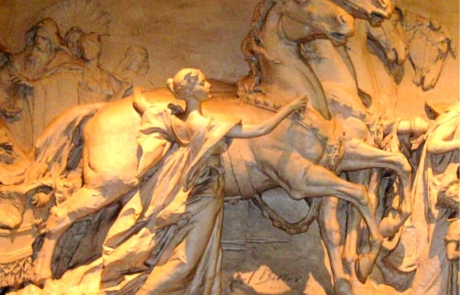
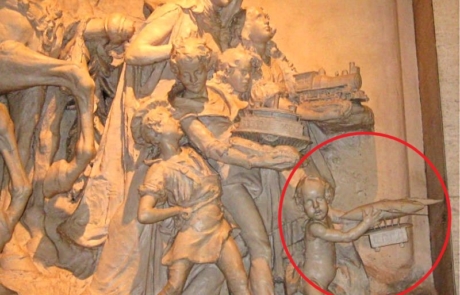


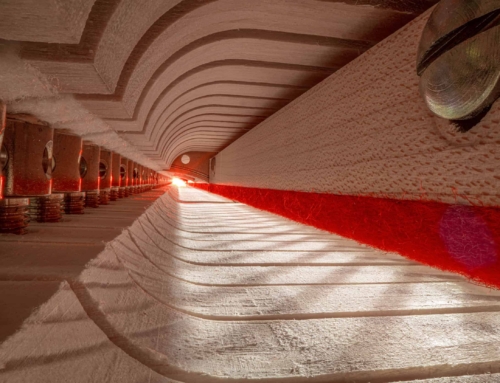
Leave A Comment